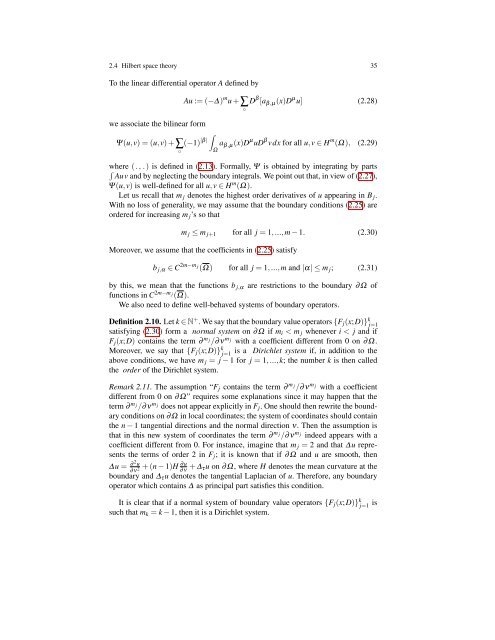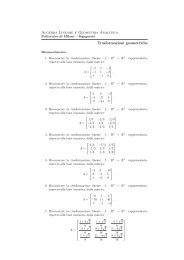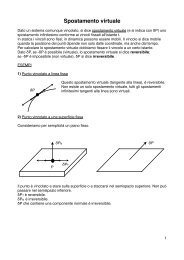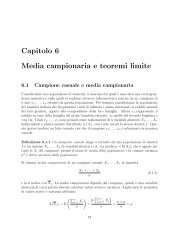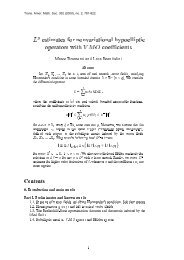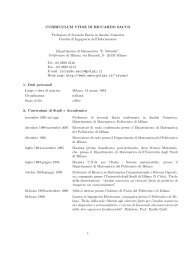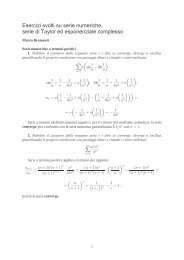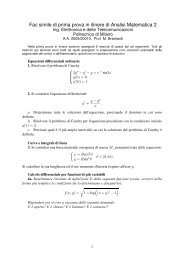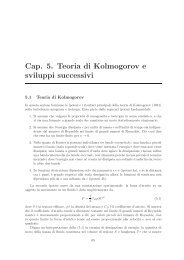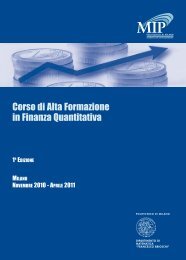- Page 1 and 2: Filippo Gazzola Hans-Christoph Grun
- Page 3 and 4: Preface Linear elliptic equations a
- Page 5 and 6: Preface vii even for polygonal boun
- Page 7 and 8: Preface ix (−∆) m u = f (u) (
- Page 9: Acknowledgements The authors are gr
- Page 12 and 13: xiv Contents 2.4.3 Inhomogeneous bo
- Page 14 and 15: xvi Contents 7.9.4 The deformation
- Page 16 and 17: 2 1 Models of higher order is attri
- Page 18 and 19: 4 1 Models of higher order • Free
- Page 20 and 21: 6 1 Models of higher order 2
- Page 22 and 23: 8 1 Models of higher order The boun
- Page 24 and 25: 10 1 Models of higher order one equ
- Page 26 and 27: 12 1 Models of higher order This me
- Page 28 and 29: 14 1 Models of higher order interes
- Page 30 and 31: 16 1 Models of higher order A few y
- Page 32 and 33: 18 1 Models of higher order Fig. 1.
- Page 34 and 35: 20 1 Models of higher order tions s
- Page 36 and 37: 22 1 Models of higher order 1.7 Qua
- Page 38 and 39: 24 1 Models of higher order bounded
- Page 40 and 41: 26 2 Linear problems We are interes
- Page 42 and 43: 28 2 Linear problems In particular,
- Page 44 and 45: 30 2 Linear problems Theorem 2.2. L
- Page 46 and 47: 32 2 Linear problems The choice of
- Page 50 and 51: 36 2 Linear problems Proposition 2.
- Page 52 and 53: 38 2 Linear problems the re-ordered
- Page 54 and 55: 40 2 Linear problems 2.4.3 Inhomoge
- Page 56 and 57: 42 2 Linear problems which proves t
- Page 58 and 59: 44 2 Linear problems Roughly speaki
- Page 60 and 61: 46 2 Linear problems 2.5.3 The Mira
- Page 62 and 63: 48 2 Linear problems by means of a
- Page 64 and 65: 50 2 Linear problems Corollary 2.29
- Page 66 and 67: 52 2 Linear problems −∆bα = v
- Page 68 and 69: 54 2 Linear problems 4. If we exten
- Page 70 and 71: 56 2 Linear problems Then existence
- Page 72 and 73: 58 2 Linear problems in [320]. Babu
- Page 74 and 75: 60 3 Eigenvalue problems 3.1 Dirich
- Page 76 and 77: 62 3 Eigenvalue problems It was Mie
- Page 78 and 79: 64 3 Eigenvalue problems Therefore,
- Page 80 and 81: 66 3 Eigenvalue problems We need to
- Page 82 and 83: 68 3 Eigenvalue problems cones also
- Page 84 and 85: 70 3 Eigenvalue problems a bounded
- Page 86 and 87: 72 3 Eigenvalue problems In 1894, L
- Page 88 and 89: 74 3 Eigenvalue problems B b |∆w
- Page 90 and 91: 76 3 Eigenvalue problems B = {Ω
- Page 92 and 93: 78 3 Eigenvalue problems Note that
- Page 94 and 95: 80 3 Eigenvalue problems The functi
- Page 96 and 97: 82 3 Eigenvalue problems This prove
- Page 98 and 99:
84 3 Eigenvalue problems The vector
- Page 100 and 101:
86 3 Eigenvalue problems Writing (3
- Page 102 and 103:
88 3 Eigenvalue problems We first g
- Page 104 and 105:
90 3 Eigenvalue problems v∆udω
- Page 106 and 107:
92 3 Eigenvalue problems (uε) ∂
- Page 108 and 109:
94 3 Eigenvalue problems For the or
- Page 111 and 112:
Chapter 4 Kernel estimates In Chapt
- Page 113 and 114:
4.2 Kernel estimates in the ball 99
- Page 115 and 116:
4.2 Kernel estimates in the ball 10
- Page 117 and 118:
4.2 Kernel estimates in the ball 10
- Page 119 and 120:
4.2 Kernel estimates in the ball 10
- Page 121 and 122:
4.2 Kernel estimates in the ball 10
- Page 123 and 124:
4.2 Kernel estimates in the ball 10
- Page 125 and 126:
4.2 Kernel estimates in the ball 11
- Page 127 and 128:
4.2 Kernel estimates in the ball 11
- Page 129 and 130:
4.3 Estimates for the Steklov probl
- Page 131 and 132:
4.3 Estimates for the Steklov probl
- Page 133 and 134:
4.4 General properties of the Green
- Page 135 and 136:
4.4 General properties of the Green
- Page 137 and 138:
4.5 Uniform Green functions estimat
- Page 139 and 140:
4.5 Uniform Green functions estimat
- Page 141 and 142:
4.5 Uniform Green functions estimat
- Page 143 and 144:
4.5 Uniform Green functions estimat
- Page 145 and 146:
4.5 Uniform Green functions estimat
- Page 147 and 148:
4.5 Uniform Green functions estimat
- Page 149 and 150:
4.5 Uniform Green functions estimat
- Page 151 and 152:
4.5 Uniform Green functions estimat
- Page 153 and 154:
4.6 Weighted estimates for the Diri
- Page 155 and 156:
4.6 Weighted estimates for the Diri
- Page 157:
4.7 Bibliographical notes 143 4.7 B
- Page 160 and 161:
146 5 Positivity and lower order pe
- Page 162 and 163:
148 5 Positivity and lower order pe
- Page 164 and 165:
150 5 Positivity and lower order pe
- Page 166 and 167:
152 5 Positivity and lower order pe
- Page 168 and 169:
154 5 Positivity and lower order pe
- Page 170 and 171:
156 5 Positivity and lower order pe
- Page 172 and 173:
158 5 Positivity and lower order pe
- Page 174 and 175:
160 5 Positivity and lower order pe
- Page 176 and 177:
162 5 Positivity and lower order pe
- Page 178 and 179:
164 5 Positivity and lower order pe
- Page 180 and 181:
166 5 Positivity and lower order pe
- Page 182 and 183:
168 5 Positivity and lower order pe
- Page 184 and 185:
170 5 Positivity and lower order pe
- Page 186 and 187:
172 5 Positivity and lower order pe
- Page 188 and 189:
174 5 Positivity and lower order pe
- Page 190 and 191:
176 5 Positivity and lower order pe
- Page 192 and 193:
178 5 Positivity and lower order pe
- Page 194 and 195:
180 5 Positivity and lower order pe
- Page 196 and 197:
182 5 Positivity and lower order pe
- Page 198 and 199:
184 6 Dominance of positivity in li
- Page 200 and 201:
186 6 Dominance of positivity in li
- Page 202 and 203:
188 6 Dominance of positivity in li
- Page 204 and 205:
190 6 Dominance of positivity in li
- Page 206 and 207:
192 6 Dominance of positivity in li
- Page 208 and 209:
194 6 Dominance of positivity in li
- Page 210 and 211:
196 6 Dominance of positivity in li
- Page 212 and 213:
198 6 Dominance of positivity in li
- Page 214 and 215:
200 6 Dominance of positivity in li
- Page 216 and 217:
202 6 Dominance of positivity in li
- Page 218 and 219:
204 6 Dominance of positivity in li
- Page 220 and 221:
206 6 Dominance of positivity in li
- Page 222 and 223:
208 6 Dominance of positivity in li
- Page 224 and 225:
210 6 Dominance of positivity in li
- Page 226 and 227:
212 6 Dominance of positivity in li
- Page 228 and 229:
214 6 Dominance of positivity in li
- Page 230 and 231:
216 6 Dominance of positivity in li
- Page 232 and 233:
218 6 Dominance of positivity in li
- Page 234 and 235:
220 6 Dominance of positivity in li
- Page 237 and 238:
Chapter 7 Semilinear problems We st
- Page 239 and 240:
7.1 A Gidas-Ni-Nirenberg type symme
- Page 241 and 242:
7.1 A Gidas-Ni-Nirenberg type symme
- Page 243 and 244:
7.1 A Gidas-Ni-Nirenberg type symme
- Page 245 and 246:
7.1 A Gidas-Ni-Nirenberg type symme
- Page 247 and 248:
7.1 A Gidas-Ni-Nirenberg type symme
- Page 249 and 250:
7.2 A brief overview of subcritical
- Page 251 and 252:
7.2 A brief overview of subcritical
- Page 253 and 254:
7.2 A brief overview of subcritical
- Page 255 and 256:
7.3 The Hilbertian critical embeddi
- Page 257 and 258:
7.3 The Hilbertian critical embeddi
- Page 259 and 260:
7.3 The Hilbertian critical embeddi
- Page 261 and 262:
7.3 The Hilbertian critical embeddi
- Page 263 and 264:
7.4 The Pohoˇzaev identity for cri
- Page 265 and 266:
7.4 The Pohoˇzaev identity for cri
- Page 267 and 268:
7.4 The Pohoˇzaev identity for cri
- Page 269 and 270:
7.5 Critical growth Dirichlet probl
- Page 271 and 272:
7.5 Critical growth Dirichlet probl
- Page 273 and 274:
7.5 Critical growth Dirichlet probl
- Page 275 and 276:
7.5 Critical growth Dirichlet probl
- Page 277 and 278:
7.5 Critical growth Dirichlet probl
- Page 279 and 280:
7.5 Critical growth Dirichlet probl
- Page 281 and 282:
7.5 Critical growth Dirichlet probl
- Page 283 and 284:
7.5 Critical growth Dirichlet probl
- Page 285 and 286:
7.5 Critical growth Dirichlet probl
- Page 287 and 288:
7.5 Critical growth Dirichlet probl
- Page 289 and 290:
7.6 Critical growth Navier problems
- Page 291 and 292:
7.6 Critical growth Navier problems
- Page 293 and 294:
7.6 Critical growth Navier problems
- Page 295 and 296:
7.7 Critical growth Steklov problem
- Page 297 and 298:
7.7 Critical growth Steklov problem
- Page 299 and 300:
7.7 Critical growth Steklov problem
- Page 301 and 302:
7.7 Critical growth Steklov problem
- Page 303 and 304:
7.7 Critical growth Steklov problem
- Page 305 and 306:
7.8 Optimal Sobolev inequalities wi
- Page 307 and 308:
7.8 Optimal Sobolev inequalities wi
- Page 309 and 310:
7.9 Critical growth problems in geo
- Page 311 and 312:
7.9 Critical growth problems in geo
- Page 313 and 314:
7.9 Critical growth problems in geo
- Page 315 and 316:
7.9 Critical growth problems in geo
- Page 317 and 318:
7.9 Critical growth problems in geo
- Page 319 and 320:
7.9 Critical growth problems in geo
- Page 321 and 322:
7.9 Critical growth problems in geo
- Page 323 and 324:
7.9 Critical growth problems in geo
- Page 325 and 326:
7.9 Critical growth problems in geo
- Page 327 and 328:
7.10 The conformally covariant Pane
- Page 329 and 330:
7.10 The conformally covariant Pane
- Page 331 and 332:
7.10 The conformally covariant Pane
- Page 333 and 334:
7.10 The conformally covariant Pane
- Page 335 and 336:
7.10 The conformally covariant Pane
- Page 337 and 338:
7.10 The conformally covariant Pane
- Page 339 and 340:
7.10 The conformally covariant Pane
- Page 341 and 342:
7.11 Fourth order equations with su
- Page 343 and 344:
7.11 Fourth order equations with su
- Page 345 and 346:
7.11 Fourth order equations with su
- Page 347 and 348:
7.11 Fourth order equations with su
- Page 349 and 350:
7.11 Fourth order equations with su
- Page 351 and 352:
7.11 Fourth order equations with su
- Page 353 and 354:
7.11 Fourth order equations with su
- Page 355 and 356:
7.11 Fourth order equations with su
- Page 357 and 358:
7.11 Fourth order equations with su
- Page 359 and 360:
7.11 Fourth order equations with su
- Page 361 and 362:
7.11 Fourth order equations with su
- Page 363 and 364:
7.11 Fourth order equations with su
- Page 365 and 366:
7.11 Fourth order equations with su
- Page 367 and 368:
7.11 Fourth order equations with su
- Page 369 and 370:
7.11 Fourth order equations with su
- Page 371 and 372:
7.11 Fourth order equations with su
- Page 373 and 374:
7.12 Bibliographical notes 359 scri
- Page 375:
7.12 Bibliographical notes 361 For
- Page 378 and 379:
364 8 Willmore surfaces of revoluti
- Page 380 and 381:
366 8 Willmore surfaces of revoluti
- Page 382 and 383:
368 8 Willmore surfaces of revoluti
- Page 384 and 385:
370 8 Willmore surfaces of revoluti
- Page 386 and 387:
372 8 Willmore surfaces of revoluti
- Page 388 and 389:
374 8 Willmore surfaces of revoluti
- Page 390 and 391:
376 8 Willmore surfaces of revoluti
- Page 392 and 393:
378 8 Willmore surfaces of revoluti
- Page 394 and 395:
380 8 Willmore surfaces of revoluti
- Page 396 and 397:
382 8 Willmore surfaces of revoluti
- Page 398 and 399:
384 8 Willmore surfaces of revoluti
- Page 400 and 401:
386 Notations en d(x) = dist(x,∂
- Page 402 and 403:
388 Notations f (t) g(t) ∃C > 0
- Page 404 and 405:
390 Bibliography Bibliography 1. R.
- Page 406 and 407:
392 Bibliography 48. M.S. Berger an
- Page 408 and 409:
394 Bibliography 96. Y.S. Choi and
- Page 410 and 411:
396 Bibliography 147. Z. Djadli, A.
- Page 412 and 413:
398 Bibliography 197. D. Gilbarg an
- Page 414 and 415:
400 Bibliography 247. C.E. Kenig. R
- Page 416 and 417:
402 Bibliography 293. V.G. Maz’ya
- Page 418 and 419:
404 Bibliography 343. G. Pólya and
- Page 420 and 421:
406 Bibliography 398. R.C.A.M. van
- Page 422 and 423:
408 Author-Index Gel’fand, I.M.,
- Page 424 and 425:
410 Subject-Index Subject-Index a p
- Page 426 and 427:
412 Subject-Index first buckling ei
- Page 428 and 429:
414 Subject-Index Poisson ratio, 5


